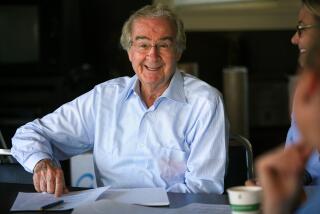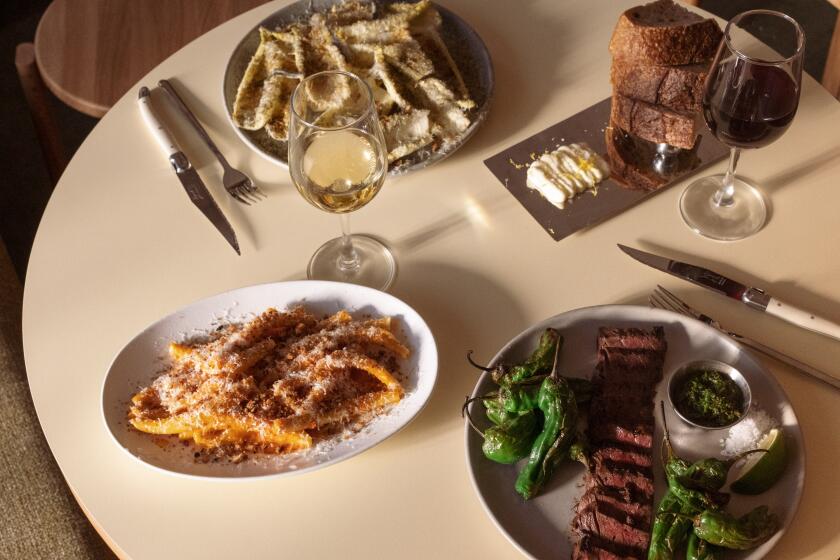A Celebration of Differences : Breitstein Firmâs 20th-Anniversary Party Leaves a Good Taste
Several weeks ago, my good friend and colleague Frank Prial published, in his âWine Talkâ column in the New York Times, a long, defensive letter from wine maker William Hill of the Napa Valley. In Hillâs letter, he offered a rebuttal to an earlier Prial piece that declared, âCalifornia wines come around more rapidly. Even the best of them mature more quickly than the lordly first growths: Chateau Haut-Brion, Lafite-Rothschild, Latour, Margaux and Mouton-Rothschild.â Happily, Prial had concluded his column by stating that âthe aging potential of California wines needs no defense.â
Unhappily, that episode served to reinforce the likelihood that making comparisons between vintages is a habit that is not about to fade away. Of course, there is merit in comparisons and in wine tastings, but one should never forget that wines, like paintings or musical compositions, affect people differently. That came into focus last month at the Calabasas Inn during the 20th anniversary celebration of the areaâs leading wine merchant, David Breitstein, whose Duke of Bourbon emporium specializes in fine vintage wines.
Several hundreds of Breitsteinâs friends and customers, along with a number of Californiaâs leading wine makers, sat down to taste 14 incredibly interesting wines. When we compared Jack Daviesâ Schramsberg 1983 Blanc de Blancs with the Schramsberg 1981 Reserve, the younger wine had a beguiling fruitiness; it was crisp and clean, with the direct sparkle most often present in a Krug or Billinger champagne. According to Davies, the 1981 was more austere, and its bouquet was more complex. Both are of flawless production, but from years of experience, I know that some wine lovers prefer the fruitier, fresh style, whereas others--and we can count the English among them--enjoy champagnes with an almost oxidized bouquet.
A third-generation Napa Valley wine maker, Michael Martini, had brought along a 1967 Louis M. Martini Private Reserve Cabernet Sauvignon, which was followed by the celebrated Martini 1970 Special Selection Cabernet Sauvignon. That is the wine that was released in a flurry of publicity after Martiniâs death in 1974, when columnist Herb Caenâs comments caused Martini fans to line up outside the winery and purchase 18,000 cases in three days. (The late founder of the winery had held back the sale of this 100% Cabernet Sauvignon because of its intensity of fruit and tannin, releasing later vintages ahead of it.) At our tasting, we noticed that the 1970 still had a mouth-feel of berryness. On the other hand, the 1967 had lost most of the fat from its skeletal armature, but it was still standing erect with an impressive delicacy.
The centerpiece of the red wines was the Louis M. Martini 1985 Special Selection Cabernet Sauvignon-Duke of Bourbon 20th-Anniversary Cuvee, composed of 86% Cabernet Sauvignon, 6% Cabernet Franc, 5% Merlot of 3% Carmine (a UC-Davis hybrid). This wine has wonderful drinkability right now, and I am sure it will be alive in the next century--which, after all, is only 13 years away. For your share, call Breitstein at (818) 341-1234. At $10 a bottle and a discount by the case, this wine can certainly let you make up your own mind, through the oncoming years, concerning the merits and longevity of our home-grown quality wines. And even while you compare them to the 1985 Bordeaux wines when these arrive, remember that yours is the only opinion that matters.
More to Read
Eat your way across L.A.
Get our weekly Tasting Notes newsletter for reviews, news and more.
You may occasionally receive promotional content from the Los Angeles Times.










